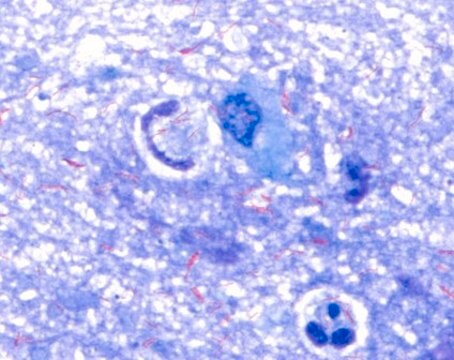Kluczowe dokumenty
77515
Methylene Blue solution
for microscopy
Synonim(y):
Ehrlich’s reagent III, Loeffler’s Methylene Blue
About This Item
Polecane produkty
klasa czystości
for microscopy
Postać
solution
okres trwałości
limited shelf life, expiry date on the label
metody
microbe id | staining: suitable
spektrum działania antybiotyku
Gram-negative bacteria
Gram-positive bacteria
przydatność
Corynebacterium spp.
bacteria
mycobacteria
spore forming microorganisms
ciąg SMILES
[Cl-].CN(C)c1ccc2N=C3C=C\C(C=C3Sc2c1)=[N+](/C)C
InChI
1S/C16H18N3S.ClH/c1-18(2)11-5-7-13-15(9-11)20-16-10-12(19(3)4)6-8-14(16)17-13;/h5-10H,1-4H3;1H/q+1;/p-1
Klucz InChI
CXKWCBBOMKCUKX-UHFFFAOYSA-M
Szukasz podobnych produktów? Odwiedź Przewodnik dotyczący porównywania produktów
Zastosowanie
Komponenty
methylene blue 0.3 g
ethanol 30 ml
water 100 ml
Inne uwagi
zastąpiony przez
Hasło ostrzegawcze
Warning
Zwroty wskazujące rodzaj zagrożenia
Zwroty wskazujące środki ostrożności
Klasyfikacja zagrożeń
Flam. Liq. 3
Kod klasy składowania
3 - Flammable liquids
Klasa zagrożenia wodnego (WGK)
WGK 2
Temperatura zapłonu (°F)
113.0 °F
Temperatura zapłonu (°C)
45 °C
Środki ochrony indywidualnej
Eyeshields, Faceshields, Gloves, type ABEK (EN14387) respirator filter
Wybierz jedną z najnowszych wersji:
Masz już ten produkt?
Dokumenty związane z niedawno zakupionymi produktami zostały zamieszczone w Bibliotece dokumentów.
Klienci oglądali również te produkty
Nasz zespół naukowców ma doświadczenie we wszystkich obszarach badań, w tym w naukach przyrodniczych, materiałoznawstwie, syntezie chemicznej, chromatografii, analityce i wielu innych dziedzinach.
Skontaktuj się z zespołem ds. pomocy technicznej






